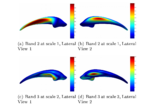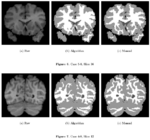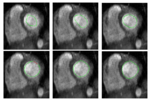Difference between revisions of "Algorithm:GATech"
| Line 6: | Line 6: | ||
== Segmentation == | == Segmentation == | ||
| + | |||
| + | {| | ||
| + | | style="width:10%" | [[Image:Gatech caudateBands.PNG|thumb|left|150px]] | ||
| + | | style="width:90%" | | ||
=== [[Algorithm:GATech:Multiscale_Shape_Segmentation|Multiscale Shape Segmentation Techniques]] === | === [[Algorithm:GATech:Multiscale_Shape_Segmentation|Multiscale Shape Segmentation Techniques]] === | ||
| Line 12: | Line 16: | ||
<font color="red">'''New: '''</font> Delphine Nain won the best student paper at [[MICCAI_2006|MICCAI 2006]] in the category "Segmentation and Registration" for her paper entitled "Shape-driven surface segmentation using spherical wavelets" by D. Nain, S. Haker, A. Bobick, A. Tannenbaum. | <font color="red">'''New: '''</font> Delphine Nain won the best student paper at [[MICCAI_2006|MICCAI 2006]] in the category "Segmentation and Registration" for her paper entitled "Shape-driven surface segmentation using spherical wavelets" by D. Nain, S. Haker, A. Bobick, A. Tannenbaum. | ||
| + | |||
| + | |- | ||
| + | |||
| + | | | [[Image:Striatum1.png|thumb|left|150px|]] | ||
| + | | | | ||
=== [[Algorithm:GATech:Rule_Based_Segmentation|Rule-Based Segmentation Techniques]] === | === [[Algorithm:GATech:Rule_Based_Segmentation|Rule-Based Segmentation Techniques]] === | ||
| Line 18: | Line 27: | ||
<font color="red">'''New: '''</font> Al-Hakim, et al. Parcellation of the Striatum. SPIE MI 2007. | <font color="red">'''New: '''</font> Al-Hakim, et al. Parcellation of the Striatum. SPIE MI 2007. | ||
| + | |||
| + | |- | ||
| + | |||
| + | | | [[Image:Circle seg.PNG|thumb|left|150px|]] | ||
| + | | | | ||
=== [[Algorithm:GATech:KPCA_Segmentation|Kernel PCA for Segmentation]] === | === [[Algorithm:GATech:KPCA_Segmentation|Kernel PCA for Segmentation]] === | ||
| Line 24: | Line 38: | ||
<font color="red">'''New: '''</font> S. Dambreville, Y. Rathi, and A. Tannenbaum. A Framework for Image Segmentation using Image Shape Models and Kernel PCA Shape Priors. PAMI. Submitted to PAMI. | <font color="red">'''New: '''</font> S. Dambreville, Y. Rathi, and A. Tannenbaum. A Framework for Image Segmentation using Image Shape Models and Kernel PCA Shape Priors. PAMI. Submitted to PAMI. | ||
| + | |||
| + | |- | ||
| + | |||
| + | | | [[Image:Fig1yan.PNG|thumb|left|150px|]] | ||
| + | | | | ||
=== [[Algorithm:GATech:Blood_Vessel_Segmentation|Blood Vessel Segmentation]] === | === [[Algorithm:GATech:Blood_Vessel_Segmentation|Blood Vessel Segmentation]] === | ||
| Line 30: | Line 49: | ||
<font color="red">'''New: '''</font>Y. Yang, S. George, D. Martin, A. Tannenbaum, and D. Giddens. 3D Modeling of Patient-Specific Geometries of Portal Veins Using MR Images. In Proceedings IEEE EMBS, 2006 | <font color="red">'''New: '''</font>Y. Yang, S. George, D. Martin, A. Tannenbaum, and D. Giddens. 3D Modeling of Patient-Specific Geometries of Portal Veins Using MR Images. In Proceedings IEEE EMBS, 2006 | ||
| + | |||
| + | |- | ||
| + | |||
| + | | | [[Image:Fig67.png|thumb|left|150px|]] | ||
| + | | | | ||
=== [[Algorithm:GATech:Knowledge_Based_Bayesian_Segmentation|Knowledge-Based Bayesian Segmentation]] === | === [[Algorithm:GATech:Knowledge_Based_Bayesian_Segmentation|Knowledge-Based Bayesian Segmentation]] === | ||
| Line 36: | Line 60: | ||
<font color="red">'''New: '''</font> J. Melonakos, Y. Gao, and A. Tannenbaum. Tissue Tracking: Applications for Brain MRI Classification. SPIE Medical Imaging, 2007. | <font color="red">'''New: '''</font> J. Melonakos, Y. Gao, and A. Tannenbaum. Tissue Tracking: Applications for Brain MRI Classification. SPIE Medical Imaging, 2007. | ||
| + | |||
| + | |- | ||
| + | |||
| + | | | [[Image:Stochastic-snake.png|thumb|left|150px|]] | ||
| + | | | | ||
=== [[Algorithm:GATech:Stochastic_Methods_Segmentation|Stochastic Methods for Segmentation]] === | === [[Algorithm:GATech:Stochastic_Methods_Segmentation|Stochastic Methods for Segmentation]] === | ||
Revision as of 15:36, 31 July 2007
Home < Algorithm:GATechContents
Overview of Georgia Tech Algorithms
At Georgia Tech, we ... put stuff from the grant here.
Current Projects
Segmentation
Multiscale Shape Segmentation TechniquesTo represent multiscale variations in a shape population in order to drive the segmentation of deep brain structures, such as the caudate nucleus or the hippocampus. New: Delphine Nain won the best student paper at MICCAI 2006 in the category "Segmentation and Registration" for her paper entitled "Shape-driven surface segmentation using spherical wavelets" by D. Nain, S. Haker, A. Bobick, A. Tannenbaum. | |||||
Rule-Based Segmentation TechniquesIn this work, we provide software to semi-automate the implementation of segmentation procedures based on expert neuroanatomist rules. New: Al-Hakim, et al. Parcellation of the Striatum. SPIE MI 2007. | |||||
Kernel PCA for SegmentationSegmentation performances using active contours can be drastically improved if the possible shapes of the object of interest are learnt. The goal of this work is to use Kernel PCA to learn shape priors. Kernel PCA allows for learning non linear dependencies in data sets, leading to more robust shape priors. New: S. Dambreville, Y. Rathi, and A. Tannenbaum. A Framework for Image Segmentation using Image Shape Models and Kernel PCA Shape Priors. PAMI. Submitted to PAMI. | |||||
Blood Vessel SegmentationThe goal of this work is to develop blood vessel segmentation techniques for 3D MRI and CT data. The methods have been applied to coronary arteries and portal veins, with promising results. New: Y. Yang, S. George, D. Martin, A. Tannenbaum, and D. Giddens. 3D Modeling of Patient-Specific Geometries of Portal Veins Using MR Images. In Proceedings IEEE EMBS, 2006 | |||||
Knowledge-Based Bayesian SegmentationThis ITK filter is a segmentation algorithm that utilizes Bayes's Rule along with an affine-invariant anisotropic smoothing filter. New: J. Melonakos, Y. Gao, and A. Tannenbaum. Tissue Tracking: Applications for Brain MRI Classification. SPIE Medical Imaging, 2007. | |||||
Stochastic Methods for SegmentationNew stochastic methods for implementing curvature driven flows for various medical tasks such as segmentation. New: Currently under investigation. RegistrationConformal FlatteningThe goal of this project is for better visualizing and computation of neural activity from fMRI brain imagery. Also, with this technique, shapes can be mapped to shperes for shape analysis, registration or other purposes. Our technique is based on conformal mappings which map genus-zero surface: in fmri case cortical or other surfaces, onto a sphere in an angle preserving manner. New: Y. Gao, J. Melonakos, and A. Tannenbaum. Conformal Flattening ITK Filter. ISC/NA-MIC Workshop on Open Science at MICCAI 2006. Optimal Mass Transport RegistrationThe goal of this project is to implement a computationaly efficient Elastic/Non-rigid Registration algorithm based on the Monge-Kantorovich theory of optimal mass transport for 3D Medical Imagery. Our technique is based on Multigrid and Multiresolution techniques. This method is particularly useful because it is parameter free and utilizes all of the grayscale data in the image pairs in a symmetric fashion and no landmarks need to be specified for correspondence. New: Tauseef ur Rehman, A. Tannenbaum. Multigrid Optimal Mass Transport for Image Registration and Morphing. SPIE Conference on Computational Imaging V, Jan 2007. DW-MRI ProcessingGeodesic Active Contours for Fiber Tractography and Fiber Bundle SegmentationIn this work, we provide an energy minimization framework which allows one to find fiber tracts and volumetric fiber bundles in brain diffusion-weighted MRI (DW-MRI). New: J. Melonakos, E. Pichon, S. Angenet, and A. Tannenbaum. Finsler Active Contours. IEEE Transactions on Pattern Analysis and Machine Intelligence, 2007 (in press). Shape Analysis
Completed ProjectsSegmentationFast Marching Slicer 2 ModuleThe Fast Marching Algorithm was added as a module to Slicer 2. Statistical/PDE Methods for SegmentationThis flow was added to Slicer 2. Image Smooth Slicer 2 Module2D and 3D smoothing of images. Affine Segment Slicer 2 ModuleThis module can be used to perform edge based segmentation. |





